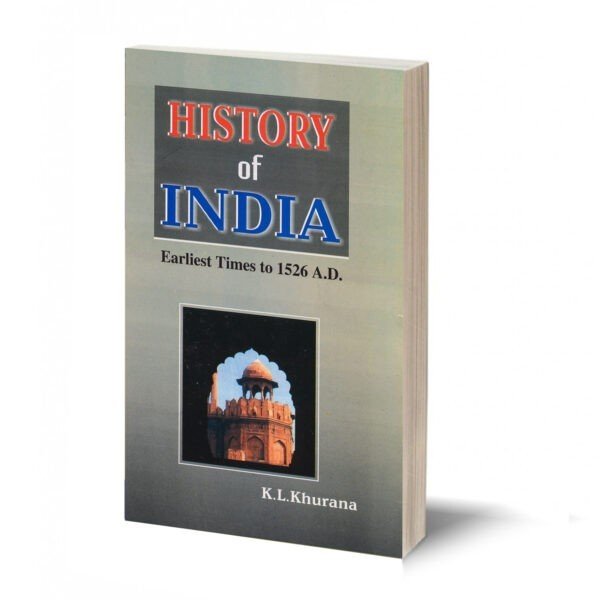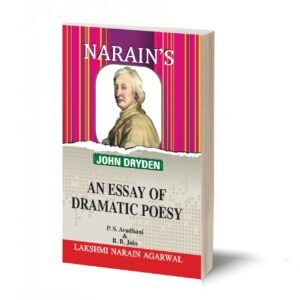History Of India ( From The Earliest Times To 1526 A.D.) -(TEXT BOOK)- By K.L. Khurana
₹448.00 – ₹840.00
For bulk quantity contact us at
Description
History Of India ( From The Earliest Times To 1526 A.D.) – , By – Dr. K.L. Khurana, ISBN Code – 978-93-86241-69-6
CONTENTS :
Chapters
- Sources of Ancient History of India
[Indigenous Sources : (A) Literary Brahminical Literature, Buddhist Literature. Jain Literature, Scientific Works. (B) Archaeological-Inscriptions, Coins, Monuments, Archaeological Antiquities. Foreign Sources—Classical Sources, Chinese Sources, Muslim Sources]
- Physical Features of India
[Mountain Ranges of the Himalayas in the North, The Great Indo-Gangetic Plain, The Deccan Plateau, Effects of Geography on History : Love for Nature, Isolation from Foreign Countries; Inability to face Foreign Invasions, Diversities, Lack of Political Unity, Unwillingness for a Great
Empire, Cultural Development, The Himalayas-—a Great Boon, Effects of the Passes, Effects ‘of Northern India,
Navigation]
- Pre-Historic Age
[Palaeolithic Age or Early Stone, Age, Mesolithic Age, Neolithic Age, Copper a Bronze Age, Iron Age]
- Indus Valley Civilization
[Chief Centres of Indus Valley Civilization, Other Centres, Main Features of Indus Valley Civilization, Destruction of Indus Valley Civilization, Differences between Indus Valley and Aryan (or Vedic) Cultures]
- The Vedic Age
[The Original Home of the Aryans, The Aryans of the Vedic Age, Social Condition of the Vedic Aryans, Economic Condition, Religious Condition, Dissimilarities between Indus Valley Civilization and Vedic Civilization, The Legacy of the Early Aryans]
- Later Vedic Age or Epic Age,
[Date of Epics, Significance of the Ramayana, Importance of Mahabharat, Political Condition during Late Vedic Age, Social Condition during Later Vedic Age, Economic Condition, Religious Condition, Caste System-Origin of the Caste System, Evolution of the Caste System, Merits of Caste System, Demerits of Caste System, The Future of Caste System in lndia.]
- Religious Movements
[Causes of the Rise of Religious Movements—Change in Vedic Religion, Sacrifices. Faith in Magic and Charms, Supremacy of the Brahmins. Caste System, Difficult Language, Intellectual Confusion due to the Theory of Karma, Gyna and Tapa Marga ; Jainism, Principles of Jainism or Teachings of Mahavir Swami, Jain Sangha and the Position of Monks, Contribution of Jainism ; Buddhism. Gautama Buddha as a Preacher, Teachings of Buddhism. Buddhist Sangha, Causes of the Rise of Buddhism, Causes of the Downfall to Buddhism, Contribution of Buddhism to Indian History, Short History of Republics during Buddhist Period, Transformation of Buddhism or Distinction between Hinayanism and Mahayanism, Comparison and Contrast between Hinduism, Jainism and Buddhism]
- The Rise of Magadha and Foreign Invasions
[Bimbisara, Ajatasatru, India during Pre-Mauryan Period, Rise and Fall of Mahapadmananda, Persian Invasions on India, Alexanders Invasion. Battle with Porus, Effects of Alexander’s Invasion]
- The Mauryan Dynasty
[Origin of Mauryas ; Chandragupta Maurya, Conquests of Chandragupta Maurya, Administration of Chandragupta Maurya, Character and Achievements of Chandragupta Maurya; Bindusara, Conquests of Bindusara.]
- Ashoka and his Successors
[Early Life of Ashoka, Conquest of Kalinga, Consequences of the Conquest of Kalinga, Administrative Reforms of Ashoka, Main Characteristics of Ashoka’s ‘Dharma’, Influence ofAshoka’s ‘Dharma’ton his Imperial Policy, Measures adopted by Ashoka for the Propagation of Buddhism, Estimate of Ashoka, Successors of Ashoka and Downfall of the Mauryan Empire, Causes of the Downfall of the Mauryan Empire, Indian Society under the Mauryas, Social Life, Position of Women, Moral Life, Religious Condition, Economic Condition, Development of Art under the Mauryas, Progress of Education.]
- The Brahmin Rulers
[Sunga Dynasty, Pushyamitra Sunga, Cultural Achievements of the Sungas ; The Kanva Dynasty ; The Andhra or Satavahana Dynasty, Important Rulers of the Satavahanas, India under the Satvahanas : Political Conditions, Social Conditions, Religious Conditions, Economic Conditions, Development of Art.]
- Foreign Invaders and their Rule in India
[The Bactrian Greek Rulers, Greek Influence on Indian Culture ; The Saka Rulers in India, Important States of the Saka Kshatraps, The Saka Rule and Indian Culture, The Kushan Dynasty, Early Rulers of the Kushan Dynasty, Kanishka. The Conquests of Kanishka, Extent of Kanishka’s
Empire, Estimate of Kanishka, Culture during the Kushan Period.]
- The Gupta Dynasty (320-540 A.D.)
[Sources of the History of the Guptas, Original Home of the Guptas, Rise of the ‘Guptas ; Chandragupta I; Main Events of the Reign of Chandragupta I; Accession of Samudragupta, Important Conquests of Samudragupta, An Estimate of Samudragupta ; Ramgupta, The Historicity of Ramgupta ; Chandragupta II or Chandragupta Vikramaditya, Conquests of Chandragupta II, An Estimate of Chandragupta II ; Kumargupta ; Skandagupta. His System of Administration, The Successors of Skandagupta or the Later Gupta Rulers ; The Hunas, The, Hunas’ Invasion on India, Effect of Hunas’ Attack on India ; Causes of the Downfall of the Gupta Empire.]
I4. Administration and Culture under the Guptas (Gupta 247 Period as Golden Period of Ancient India)
[Fahien’s Account of India : Administrative Organisation of the Guptas : Central Administration, Provincial Administration, Local Administration, Judicial Administration, Revenue System, Military Organisation ; Position of Women ; The Gupta Art, Main Characteristics of the Gupta Art]
- Harsha and His Times (606-647 A.D.)
[Political Condition of India ; Sources of Harsha’s Reign ; Career and Achievements of Harsha, Cultural Activities of the Reign of Harsha, Administration of Harsha ; Hieun Tsang’s Account of India ; Estimate of King Harsha, Harsha’s Place in History.]
- The Rajput Period (650-1206 A.D.)
[The Origin of Rajputs ; Important Rajput Dynasties and their Rulers : The Gurjara Pratiharas, The Gahadvalas, The Palas, Achievements of Pala Kings ; The Tripartite Rulers ; The Chauhans, Prithviraj III, Estimate of Prithviraj ; Causes of the Downfall of Chauhans; The Solankis or Chalukyas of Gujarat ; The Chandelas ; The Paramaras, Important Rulers of Parmara Dynasty]
- Ruling Dynasties of the South
[The Chalukyas ; Religion and Art during Chalukya Period ; The Rashtrakutas ; Achievements of the Rashtrakutas ; The Pallavas, Administration of Pallavas ; The Cholas, Administration of the Chola Rulers, Cultural Contribution of Chola Kings ; Other Ruling Dynasties of the South : The Yadavas of Deogiri, Kakativas ol’ Warangal. Pandya Dynasty of Madura. The Cheras, The Hoysala Dynasty.]
- Rajput Civilization and Culture
[Salient Features of the Rajput Period, Political Condition, Social Condition, Condition of Rajput Women. General Conditions, Religious Condition, Rajput Art. Education etc. ; India on the Eve of Muslim Invasions, Causes of the Failures of the Rajputs.]
- The Arab Invasion of Sindh
[Causes of the Arab Invasion, Events of the Arab ‘Invasion, Causes of the Success of the Arabs, Effects of Arab Invasion. Administration of the Arabs, Why the Arabs failed to establish a Permanent Empire in India.]
- The Rise of Turks
[Rise of Ghazni under Sabuktagin ; Mahmood of Ghazni, Aims and Motives of Mahmood’s Invasions on India, Mahmood’s Invasions on India, Causes of the Success of Mahmood, Effects of Mahmood’s Invasions, Character and Personality of Mahmood Ghaznavi, Successors of Mahmood Ghaznavi.]
- Shihabuddin alias Muizuddin Muhammad Ghori (1175-1250 A.D.)
[Indian Campaigns of Muhammad Ghori and His Objectives ; Expedition of Muhammad Ghori to India, An Estimate of Muhammad Ghori ; Causes of the Success of Muhammad Ghori against the Rajputs, Effects of Invasions of Muhammad Ghori.]
- Greater India
[Causes of Colonization, Relations of India with other Countries, Causes of the Downfall of the Indian Colonial Empire, Spread of Indian Culture in South East Asia.]
Some Important Questions
Short Questions and Answers
Objective Type Questions and Answers
Some Important Dates of Ancient India
Suggested Readings
From A. D. 1200 to A. D. 1526
- Significant Source Material of Medieval India
- Rise of Islam and Arab Invasion of Sindh
- Rise of the Turks
- Shihabuddin Alias Muizuddin Muhammad Ghori (A. D. 1175 to 1250)
- The So-called Slave Dynasty (A. D. 1206 to 1290)
- Shamsuddin Iltutmish (A. D. 1211 to 1236)
- The Successors of lltutmish and the Rule of ‘The Forty’ (A. D. 1236 to 1266)
- Ghiasuddin Balban (A. D. 1266 to 1287)
- Successors of Balban and Decline of Slave Dynasty
- Khalji Dynasty (A. D. 1290 to 1320)
- Alauddin Khalji (A. D. 1296-1316)
- Successors of Alauddin Khalji and Downfall of Khalji Empire
- Tughlaq Dynasty (A.D. 1320 to 1414)
- Muhammad-bin-Tughlaq (A.D. 1325 to 1351)
- Firoz Shah Tughlaq (A.D. 1351 to 1388)
- Later Tughlugs and Invasion of Timur
- Sayyid Dynasty
- Lodi Dynasty (A. D. 1451 to 1526)
- Administration of Delhi Sultanate
- Society and Culture during Delhi Sultanate
- Rise of Provincial Kingdoms
Model Questions
Important Dates
Objective Questions and their Answers
Short Questions and Answers
Additional information
| Weight | 0.7 kg |
|---|---|
| Dimensions | 22 × 14 × 2 cm |
| Cover Type | Hard Bound Edition, Paper Back Edition |










Reviews
There are no reviews yet.